Polyphenols-Loaded Sericin Self-Assembling Nanoparticles: A Slow-Release for Regeneration by Tissue-Resident Mesenchymal Stem/Stromal Cells
Abstract
1. Introduction
2. Materials and Methods
2.1. Materials
2.2. Nanoparticle Preparation and Characterization
2.2.1. Silk Sericin Extraction
2.2.2. Nanoparticle Preparation
2.2.3. Drug Loading, Production Yield and Encapsulation Efficiency Evaluation
2.2.4. Nanoparticle Size Distribution
2.2.5. Morphological Evaluation by Scanning Electron Microscopy (SEM)
2.2.6. Physical-Chemical Characterization
2.2.7. In Vitro Drug Release Test
2.2.8. Drug Release Kinetic Study
2.3. In Vitro Biological Activity
2.3.1. ROS-Scavenging Activity
2.3.2. Anti-Elastase Activity
2.3.3. Anti-Tyrosinase Activity
2.3.4. Cell Metabolic Activity Evaluation
2.3.5. Oxidative Stress Protection Test
2.4. Statistical Analysis
3. Results and Discussion
4. Conclusions
Supplementary Materials
Author Contributions
Funding
Acknowledgments
Conflicts of Interest
References
- Fu, Y.; Karbaat, L.; Wu, L.; Leijten, J.; Both, S.K.; Karperien, M. Trophic Effects of Mesenchymal Stem Cells in Tissue Regeneration. Tissue Eng. Part B Rev. 2017, 23, 515–528. [Google Scholar] [CrossRef] [PubMed]
- Li, Y.; Wu, Q.; Wang, Y.; Li, L.; Bu, H.; Bao, J. Senescence of mesenchymal stem cells. Int. J. Mol. Med. 2017, 39, 775–782. [Google Scholar] [CrossRef] [PubMed]
- Bari, E.; Ferrarotti, I.; Torre, M.L.; Corsico, A.G.; Perteghella, S. Mesenchymal stem/stromal cell secretome for lung regeneration: The long way through “pharmaceuticalization” for the best formulation. J. Control. Release 2019, 309, 11–24. [Google Scholar] [CrossRef]
- Zhang, D.; Chen, Y.; Xu, X.; Xiang, H.; Shi, Y.; Gao, Y.; Wang, X.; Jiang, X.; Li, N.; Pan, J. Autophagy inhibits the mesenchymal stem cell aging induced by d-galactose through ROS/JNK/p38 signalling. Clin. Exp. Pharmacol. Physiol. 2020, 47, 466–477. [Google Scholar] [CrossRef] [PubMed]
- Denu, R.A.; Hematti, P. Effects of Oxidative Stress on Mesenchymal Stem Cell Biology. Oxidative Med. Cell. Longev. 2016. [Google Scholar] [CrossRef]
- Alexander, V.A.D.; Radhakrishnan, A.; Subramani, P. Overviews of Biological Importance of Quercetin: A Bioactive Flavonoid. Pharmacogn. Rev 2016, 10, 84–89. [Google Scholar]
- Rauf, A.; Imran, M.; Abu-Izneid, T.; Iahfisham Ul, H.; Patel, S.; Pan, X.D.; Naz, S.; Silva, A.S.; Saeed, F.; Suleria, H.A.R. Proanthocyanidins: A comprehensive review. Biomed. Pharmacother. 2019, 116. [Google Scholar] [CrossRef]
- Bartosikova, L.; Necas, J. Epigallocatechin gallate: A review. Veterinarni Med. 2018, 63, 443–467. [Google Scholar] [CrossRef]
- McCarty, S.M.; Percival, S.L. Proteases and Delayed Wound Healing. Adv. Wound Care 2013, 2, 438–447. [Google Scholar] [CrossRef]
- Wang, Y.-J.; Zhang, Y.-Q. Three-layered sericins around the silk fibroin fiber from Bombyx mori cocoon and their amino acid composition. Silk Inherit. Innov. Mod. Silk Road 2011, 175–176, 158–163. [Google Scholar] [CrossRef]
- Chlapanidas, T.; Farago, S.; Lucconi, G.; Perteghella, S.; Galuzzi, M.; Mantelli, M.; Avanzini, M.A.; Tosca, M.C.; Marazzi, M.; Vigo, D.; et al. Sericins exhibit ROS-scavenging, anti-tyrosinase, anti-elastase, and in vitro immunomodulatory activities. Int. J. Biol. Macromol. 2013, 58, 47–56. [Google Scholar] [CrossRef] [PubMed]
- Lamboni, L.; Gauthier, M.; Yang, G.; Wang, Q. Silk sericin: A versatile material for tissue engineering and drug delivery. Biotechnol Adv. 2015, 33, 1855–1867. [Google Scholar] [CrossRef] [PubMed]
- Bari, E.; Arciola, C.R.; Vigani, B.; Crivelli, B.; Moro, P.; Marrubini, G.; Sorrenti, M.; Catenacci, L.; Bruni, G.; Chlapanidas, T.; et al. In Vitro Effectiveness of Microspheres Based on Silk Sericin and Chlorella vulgaris or Arthrospira platensis for Wound Healing Applications. Materials 2017, 10, 983. [Google Scholar] [CrossRef] [PubMed]
- Crivelli, B.; Perteghella, S.; Bari, E.; Sorrenti, M.; Tripodo, G.; Chlapanidas, T.; Torre, M.L. Silk nanoparticles: From inert supports to bioactive natural carriers for drug delivery. Soft Matter 2018, 14, 546–557. [Google Scholar] [CrossRef]
- Bari, E.; Perteghella, S.; Farago, S.; Torre, M.L. Association of silk sericin and platelet lysate: Premises for the formulation of wound healing active medications. Int. J. Biol. Macromol. 2018, 119, 37–47. [Google Scholar] [CrossRef]
- Aramwit, P.; Siritientong, T.; Srichana, T. Potential applications of silk sericin, a natural protein from textile industry by-products. Waste Manag. Res. 2012, 30. [Google Scholar] [CrossRef]
- Nardini, M.; Perteghella, S.; Mastracci, L.; Grillo, F.; Marrubini, G.; Bari, E.; Formica, M.; Gentili, C.; Cancedda, R.; Torre, M.L.; et al. Growth Factors Delivery System for Skin Regeneration: An Advanced Wound Dressing. Pharmaceutics 2020, 12, 120. [Google Scholar] [CrossRef]
- Bari, E.; Perteghella, S.; Marrubini, G.; Sorrenti, M.; Catenacci, L.; Tripodo, G.; Mastrogiacomo, M.; Mandracchia, D.; Trapani, A.; Farago, S.; et al. In vitro efficacy of silk sericin microparticles and platelet lysate for intervertebral disk regeneration. Int. J. Biol. Macromol. 2018, 118, 792–799. [Google Scholar] [CrossRef]
- Aramwit, P.; Yamdech, R.; Ampawong, S. Controlled Release of Chitosan and Sericin from the Microspheres-Embedded Wound Dressing for the Prolonged Anti-microbial and Wound Healing Efficacy. AAPS J. 2016, 18, 647–658. [Google Scholar] [CrossRef]
- Suktham, K.; Koobkokkruad, T.; Wutikhun, T.; Surassmo, S. Efficiency of resveratrol-loaded sericin nanoparticles: Promising bionanocarriers for drug delivery. Int. J. Pharm. 2018, 537, 48–56. [Google Scholar] [CrossRef]
- Mandal, B.B.; Kundu, S.C. Self-assembled silk sericin/poloxamer nanoparticles as nanocarriers of hydrophobic and hydrophilic drugs for targeted delivery. Nanotechnology 2009, 20. [Google Scholar] [CrossRef] [PubMed]
- Cho, K.Y.; Moon, J.Y.; Lee, Y.W.; Lee, K.G.; Yeo, J.H.; Kweon, H.Y.; Kim, K.H.; Cho, C.S. Preparation of self-assembled silk sericin nanoparticles. Int. J. Biol. Macromol. 2003, 32, 36–42. [Google Scholar] [CrossRef]
- Parisi, O.I.; Fiorillo, M.; Scrivano, L.; Sinicropi, M.S.; Dolce, V.; Iacopetta, D.; Puoci, F.; Cappello, A.R. Sericin/Poly(ethylcyanoacrylate) Nanospheres by Interfacial Polymerization for Enhanced Bioefficacy of Fenofibrate: In Vitro and In Vivo Studies. Biomacromolecules 2015, 16, 3126–3133. [Google Scholar] [CrossRef] [PubMed]
- Huang, L.; Tao, K.; Liu, J.; Qi, C.; Xu, L.; Chang, P.; Gao, J.; Shuai, X.; Wang, G.; Wang, Z.; et al. Design and Fabrication of Multifunctional Sericin Nanoparticles for Tumor Targeting and pH-Responsive Subcellular Delivery of Cancer Chemotherapy Drugs. ACS Appl. Mater. Interfaces 2016, 8, 6577–6585. [Google Scholar] [CrossRef]
- Kanoujia, J.; Singh, M.; Singh, P.; Saraf, S.A. Novel genipin crosslinked atorvastatin loaded sericin nanoparticles for their enhanced antihyperlipidemic activity. Mater. Sci. Eng. C Mater. Biol. Appl. 2016, 69, 967–976. [Google Scholar] [CrossRef] [PubMed]
- Hazeri, N.; Tavanai, H.; Moradi, A.R. Production and properties of electrosprayed sericin nanopowder. Sci. Technol. Adv. Mater. 2012, 13. [Google Scholar] [CrossRef]
- Perteghella, S.; Crivelli, B.; Catenacci, L.; Sorrenti, M.; Bruni, G.; Necchi, V.; Vigani, B.; Sorlini, M.; Torre, M.L.; Chlapanidas, T. Stem cell-extracellular vesicles as drug delivery systems: New frontiers for silk/curcumin nanoparticles. Int. J. Pharm. 2017, 520, 86–97. [Google Scholar] [CrossRef]
- Guo, W.; Deng, L.; Yu, J.; Chen, Z.; Woo, Y.; Liu, H.; Li, T.; Lin, T.; Chen, H.; Zhao, M.; et al. Sericin nanomicelles with enhanced cellular uptake and pH-triggered release of doxorubicin reverse cancer drug resistance. Drug Deliv. 2018, 25, 1103–1116. [Google Scholar] [CrossRef]
- Couvreur, P. Nanoparticles in drug delivery: Past, present and future. Adv. Drug Deliv. Rev. 2013, 65, 21–23. [Google Scholar] [CrossRef]
- Crivelli, B.; Bari, E.; Perteghella, S.; Catenacci, L.; Sorrenti, M.; Mocchi, M.; Farago, S.; Tripodo, G.; Prina-Mello, A.; Torre, M.L. Silk fibroin nanoparticles for celecoxib and curcumin delivery: ROS-scavenging and anti-inflammatory activities in an in vitro model of osteoarthritis. Eur. J. Pharm. Biopharm. 2019, 137, 37–45. [Google Scholar] [CrossRef]
- Caccavo, D. An overview on the mathematical modeling of hydrogels’ behavior for drug delivery systems. Int. J. Pharm. 2019, 560, 175–190. [Google Scholar] [CrossRef] [PubMed]
- Bari, E.; Perteghella, S.; Di Silvestre, D.; Sorlini, M.; Catenacci, L.; Sorrenti, M.; Marrubini, G.; Rossi, R.; Tripodo, G.; Mauri, P.; et al. Pilot Production of Mesenchymal Stem/Stromal Freeze-Dried Secretome for Cell-Free Regenerative Nanomedicine: A Validated GMP-Compliant Process. Cells 2018, 7, 190. [Google Scholar] [CrossRef] [PubMed]
- della Cuna, F.S.R.; Calevo, J.; Bari, E.; Giovannini, A.; Boselli, C.; Tava, A. Characterization and Antioxidant Activity of Essential Oil of Four Sympatric Orchid Species. Molecules 2019, 24, 3878. [Google Scholar] [CrossRef]
- Bari, E.; Ferrarotti, I.; Di Silvestre, D.; Grisoli, P.; Barzon, V.; Balderacchi, A.; Torre, M.L.; Rossi, R.; Mauri, P.; Corsico, A.G.; et al. Adipose Mesenchymal Extracellular Vesicles as α-1-Antitrypsin Physiological Delivery Systems for Lung Regeneration. Cells 2019, 8, 965. [Google Scholar] [CrossRef] [PubMed]
- Dominici, M.; Le Blanc, K.; Mueller, I.; Slaper-Cortenbach, I.; Marini, F.C.; Krause, D.S.; Deans, R.J.; Keating, A.; Prockop, D.J.; Horwitz, E.M. Minimal criteria for defining multipotent mesenchymal stromal cells. The International Society for Cellular Therapy position statement. Cytotherapy 2006, 8, 315–317. [Google Scholar] [CrossRef]
- Hanafy, N.A.N.; El-Kemary, M.; Leporatti, S. Micelles Structure Development as a Strategy to Improve Smart Cancer Therapy. Cancers 2018, 10, 238. [Google Scholar] [CrossRef]
- Khonkarn, R.; Mankhetkorn, S.; Hennink, W.E.; Okonogi, S. PEG-OCL micelles for quercetin solubilization and inhibition of cancer cell growth. Eur. J. Pharm. Biopharm. 2011, 79, 268–275. [Google Scholar] [CrossRef]
- Li, Y.; Yang, L. Driving forces for drug loading in drug carriers. J. Microencapsul. 2015, 32, 255–272. [Google Scholar] [CrossRef]
- Sunoqrot, S.; Alsadi, A.; Tarawneh, O.; Hamed, R. Polymer type and molecular weight dictate the encapsulation efficiency and release of Quercetin from polymeric micelles. Colloid Polym. Sci. 2017, 295, 2051–2059. [Google Scholar] [CrossRef]
- Catenacci, L.; Sorrenti, M.; Bruni, G.; Bonferoni, C.M.; Sandri, G.; Bettinetti, G. Characterization of silver sulfadiazine-loaded solid lipid nanoparticles by thermal analysis. J. Therm. Anal. Calorim. 2013, 111, 2149–2155. [Google Scholar] [CrossRef]
- Peppas, N.A.; Sahlin, J.J. A simple equation for the description of solute release. 3. Coupling of diffusion and relaxation. Int. J. Pharm. 1989, 57, 169–172. [Google Scholar] [CrossRef]
- Park, Y.S.; Jeon, M.H.; Hwang, H.J.; Park, M.R.; Lee, S.-H.; Kim, S.G.; Kim, M. Antioxidant activity and analysis of proanthocyanidins from pine (Pinus densiflora) needles. Nutr. Res. Pract. 2011, 5, 281–287. [Google Scholar] [CrossRef] [PubMed]
- Hatahet, T.; Morille, M.; Shamseddin, A.; Aubert-Pouessel, A.; Devoisselle, J.M.; Begu, S. Dermal quercetin lipid nanocapsules: Influence of the formulation on antioxidant activity and cellular protection against hydrogen peroxide. Int. J. Pharm. 2017, 518, 167–176. [Google Scholar] [CrossRef] [PubMed]
- Legeay, S.; Rodier, M.; Fillon, L.; Faure, S.; Clere, N. Epigallocatechin Gallate: A Review of Its Beneficial Properties to Prevent Metabolic Syndrome. Nutrients 2015, 7, 5443–5468. [Google Scholar] [CrossRef]
- Hong, Y.-H.; Jung, E.Y.; Noh, D.O.; Suh, H.J. Physiological effects of formulation containing tannase-converted green tea extract on skin care: Physical stability, collagenase, elastase, and tyrosinase activities. Integr. Med. Res. 2014, 3, 25–33. [Google Scholar] [CrossRef]
- Pientaweeratch, S.; Panapisal, V.; Tansirikongkol, A. Antioxidant, anti-collagenase and anti-elastase activities of Phyllanthus emblica, Manilkara zapota and silymarin: An in vitro comparative study for anti-aging applications. Pharm. Biol. 2016, 54, 1865–1872. [Google Scholar] [CrossRef]
- Bos, M.A.; Vennat, B.; Meunier, M.T.; Pouget, M.P.; Pourrat, A.; Fialip, J. Procyanidins from tormentil: Antioxidant properties towards lipoperoxidation and anti-elastase activity. Biol. Pharm. Bull. 1996, 19, 146–148. [Google Scholar] [CrossRef]
- Zolghadri, S.; Bahrami, A.; Khan, M.T.H.; Munoz-Munoz, J.; Garcia-Molina, F.; Garcia-Canovas, F.; Saboury, A.A. A comprehensive review on tyrosinase inhibitors. J. Enzyme Inhib. Med. Chem. 2019, 34, 279–309. [Google Scholar] [CrossRef]
- Kato, N.; Sato, S.; Yamanaka, A.; Yamada, H.; Fuwa, N.; Nomura, M. Silk protein, sericin, inhibits lipid peroxidation and tyrosinase activity. Biosci. Biotechnol. Biochem. 1998, 62, 145–147. [Google Scholar] [CrossRef]
- Kubo, I.; Kinst-Hori, I. Flavonols from saffron flower: Tyrosinase inhibitory activity and inhibition mechanism. J. Agric. Food Chem. 1999, 47, 4121–4125. [Google Scholar] [CrossRef]
- Cao, T.-T.; Zhang, Y.-Q. Processing and characterization of silk sericin from Bombyx mori and its application in biomaterials and biomedicines. Mater. Sci. Eng. C Mater. Biol. Appl. 2016, 61, 940–952. [Google Scholar] [CrossRef] [PubMed]
- Sapru, S.; Das, S.; Mandal, M.; Ghosh, A.K.; Kundu, S.C. Nonmulberry silk protein sericin blend hydrogels for skin tissue regeneration—In vitro and in vivo. Int. J. Biol. Macromol. 2019, 137, 545–553. [Google Scholar] [CrossRef] [PubMed]
- Kulakowski, D.; Leme-Kraus, A.A.; Nama, J.-W.; McAlpine, J.; Chen, S.-N.; Pauli, G.F.; Ravindran, S.; Bedran-Russo, A.K. Oligomeric proanthocyanidins released from dentin induce regenerative dental pulp cell response. Acta Biomater. 2017, 55, 262–270. [Google Scholar] [CrossRef]
- Kim, Y.J.; Bae, Y.C.; Suh, K.T.; Jung, J.S. Quercetin, a flavonoid, inhibits proliferation and increases osteogenic differentiation in human adipose stromal cells. Biochem. Pharm. 2006, 72, 1268–1278. [Google Scholar] [CrossRef] [PubMed]
- Widowati, W.; Tan Sardjono, C.; Wijaya, C.; Laksmitawati, D.R.; Sandra, F. Extract of Curcuma longa L. and (-)-Epigallo Catechin-3-Gallate Enhanced Proliferation of Adipose Tissue–derived Mesenchymal Stem Cells (AD-MSCs) and Differentiation of AD-MSCs into Endothelial Progenitor Cells. J. US China Med. Sci. 2012, 9, 22–29. [Google Scholar] [CrossRef][Green Version]
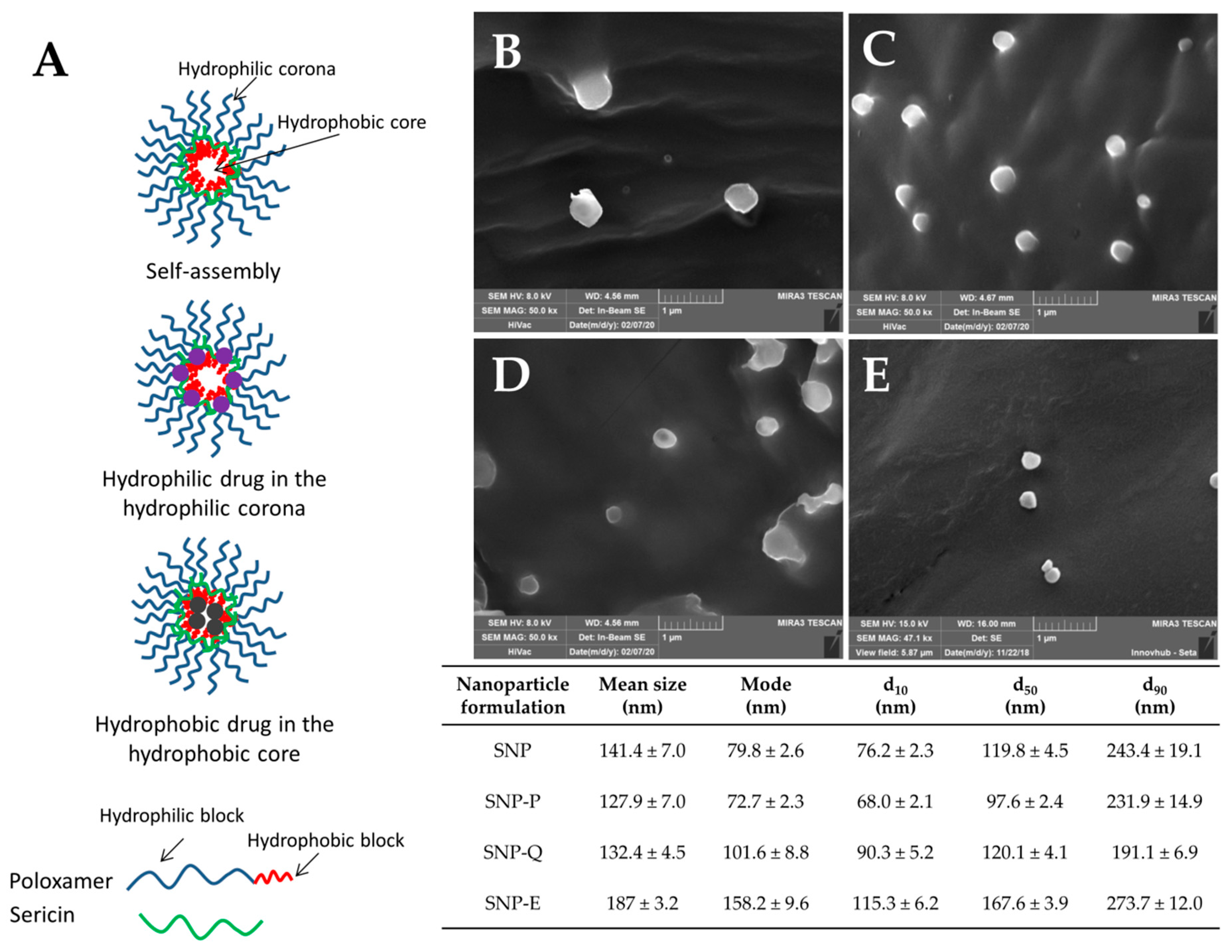
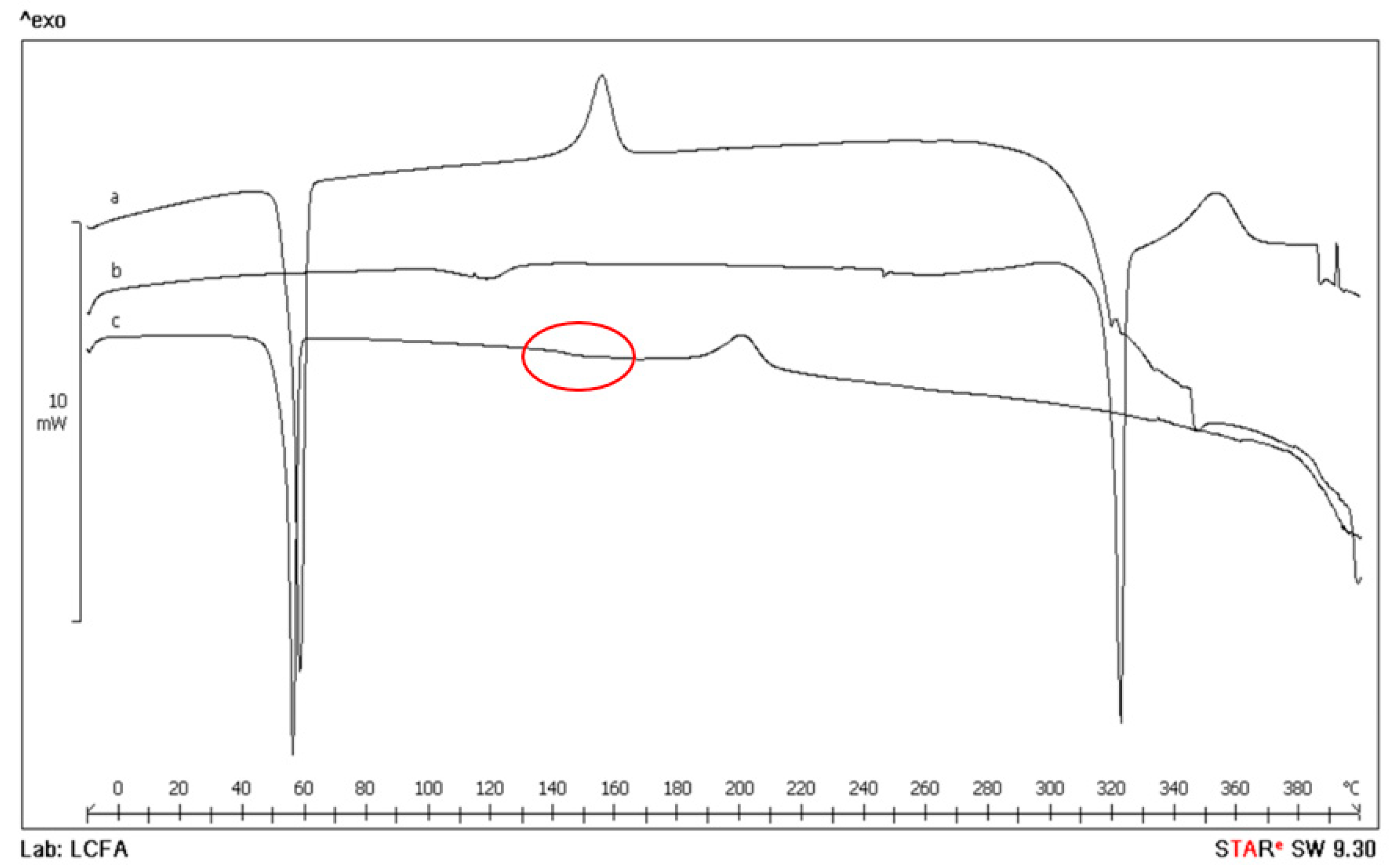
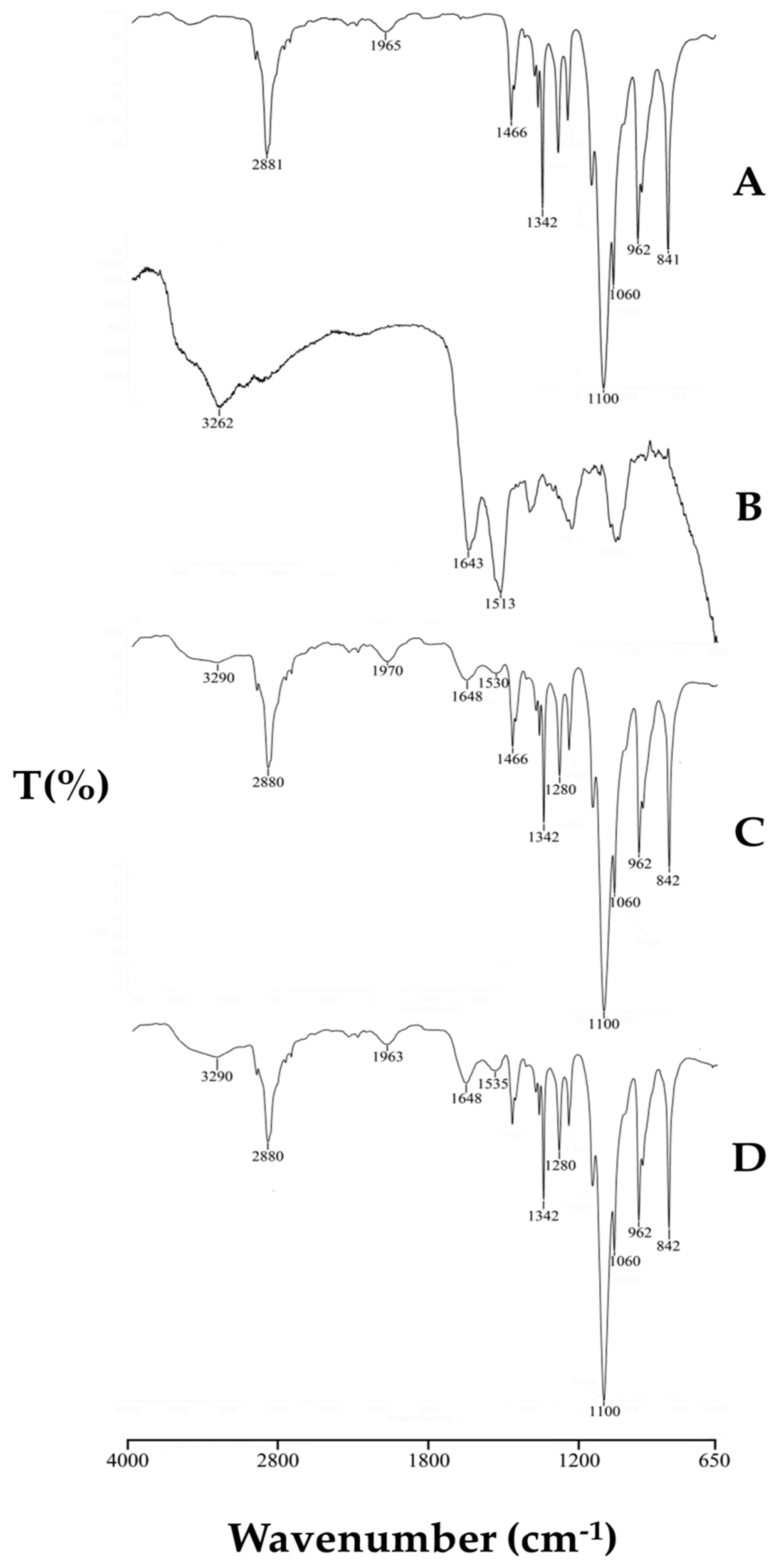
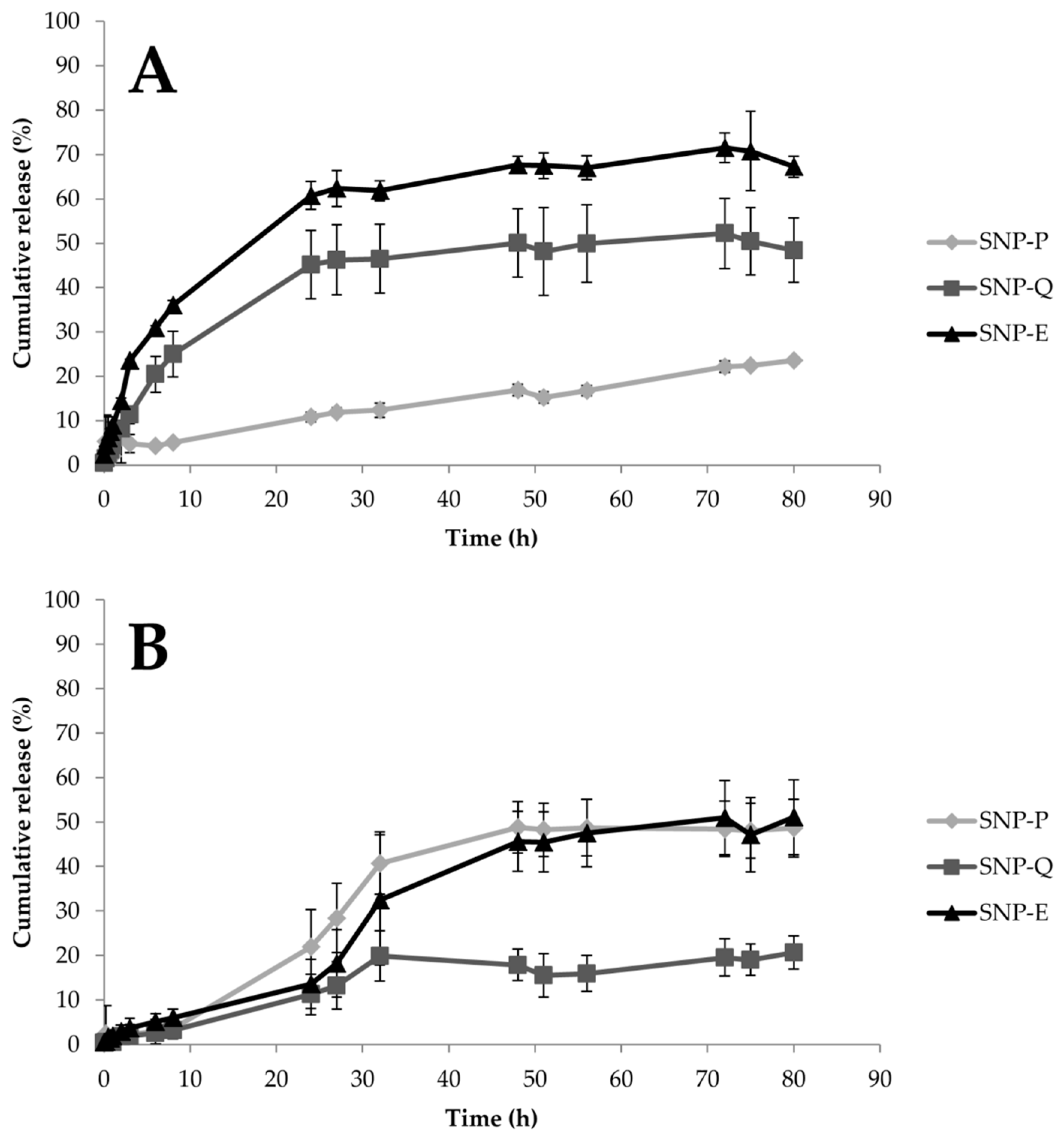
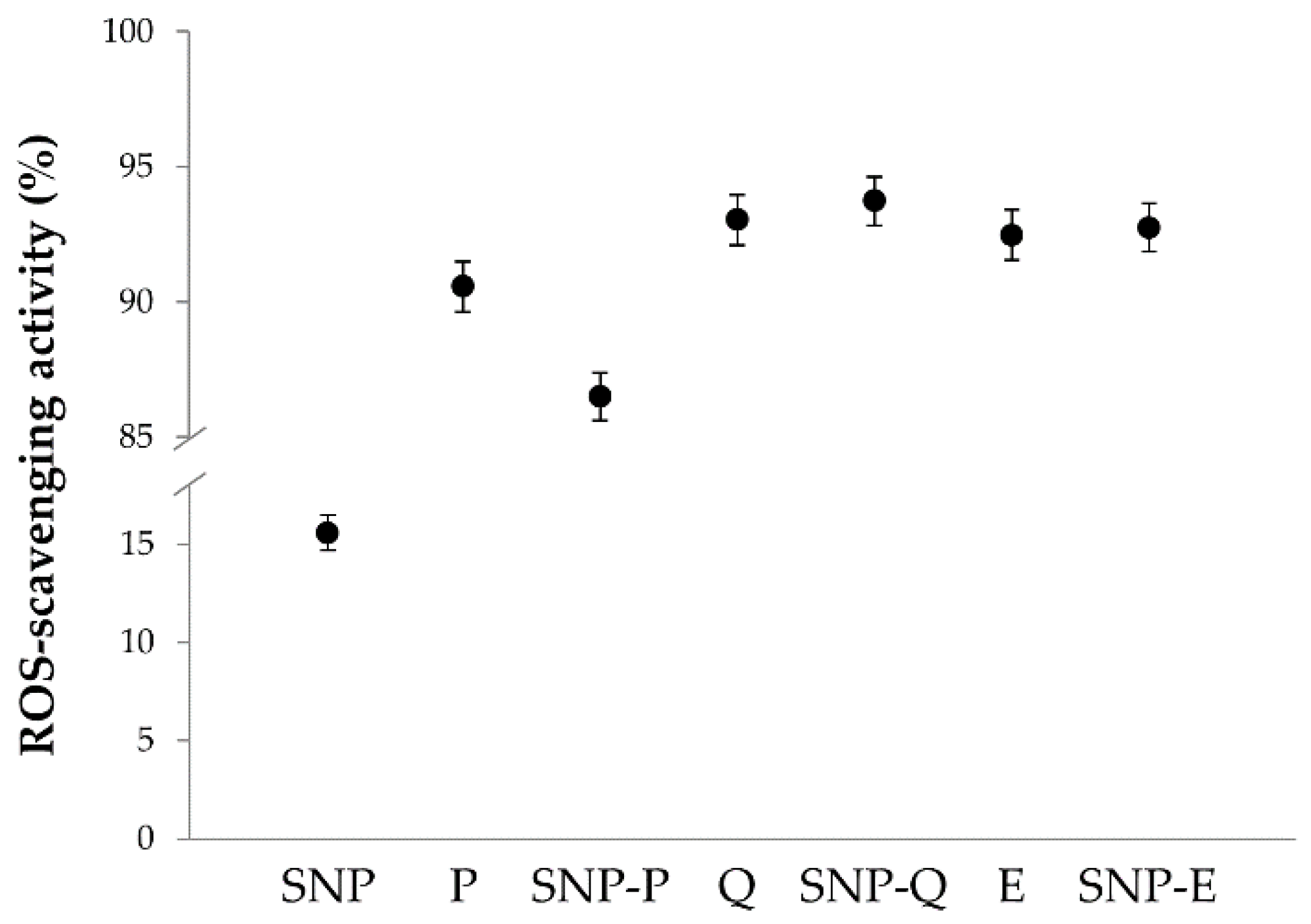
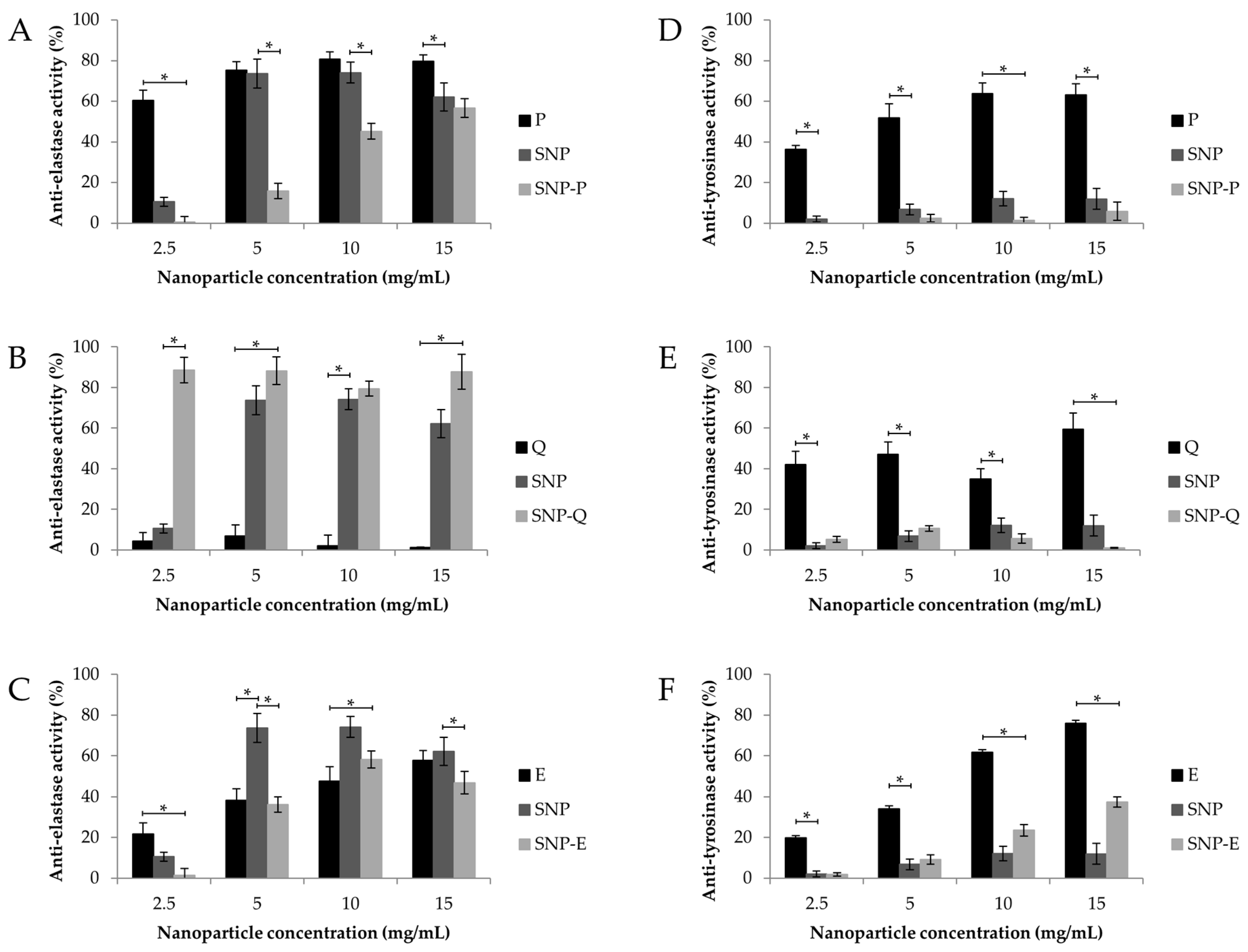

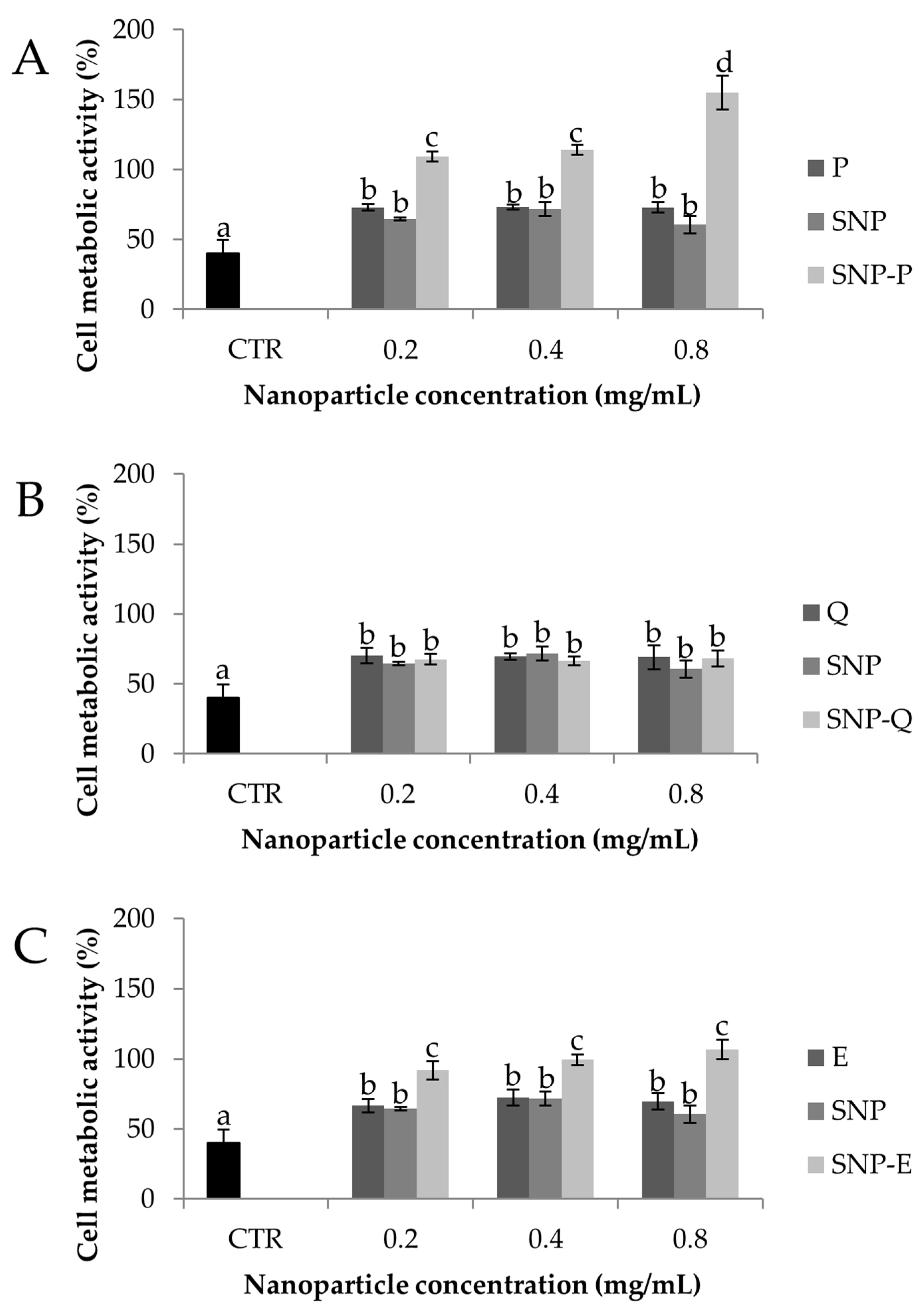
| Formulation | Active Ingredient | Theoretical Drug Loading (%, w/w) |
|---|---|---|
| SNP | / | / |
| SNP-P | Proanthocyanidins (P) | 3.2 |
| SNP-Q | Quercetin (Q) | 3.2 |
| SNP-E | Epigallocatechin gallate (E) | 3.2 |
| Nanoparticle Formulation | Process Yield (%) | Drug Loading (% w/w) | Encapsulation Efficiency (%) |
|---|---|---|---|
| SNP | 62.6 ± 5.68 a | - | - |
| SNP-P | 63.8 ± 4.25 a | 2.6 ± 0.37 a | 82.2 ± 11.58 a |
| SNP-Q | 60.9 ± 0.46 a | 0.7 ± 0.21 b | 20.5 ± 6.59 b |
| SNP-E | 63.7 ± 1.79 a | 1.3 ± 0.17 c | 41.5 ± 5.25 c |
| Model | Equation | Sample | Dissolution Medium | Coefficients (95% Confidence Bounds) | Sum of Squares | R2 | Degrees of Freedom | SE |
|---|---|---|---|---|---|---|---|---|
| Higuchi | F(t) = k × t0.5 | SNP-E | PBS | k = 5.516 (5.261, 5.771) | 11,734 | 0.8421 | 161 | 0.1290 |
| EtOH | k = 9.265 (8.821, 9.709) | 3787 | 0.9051 | 53 | 0.2213 | |||
| SNP-Q | PBS | k = 2.319 (2.137, 2.501) | 635.8 | 0.8396 | 53 | 0.09066 | ||
| EtOH | k = 6.895 (6.620, 7.170) | 13,653 | 0.8378 | 161 | 0.1392 | |||
| SNP-P | PBS | k = 5.801 (5.564, 6.039) | 10,214 | 0.8694 | 161 | 0.1204 | ||
| EtOH | k = 2.432 (2.285, 2.579) | 416.5 | 0.868 | 53 | 0.07338 | |||
| Higuchi (eq 2.12 from [31]) | F(t) = 100 × (1 − C × exp(−k×t)) | SNP-E | PBS | C = 0.9979 (0.9819, 1.014) k = 0.009999 (0.009381, 0.01063) | 7962 | 0.8928 | 160 | C 0.008122 k 0.0003151 |
| EtOH | C = 0.8826 (0.8430, 0.9226) k = 0.02064 (0.01780, 0.02389) | 4440 | 0.8888 | 52 | C 0.01936 k 0.00136 | |||
| SNP-Q | PBS | C = 0.9837 (0.9687, 0.9987) k = 0.003084 (0.002645, 0.003528) | 786.6 | 0.8016 | 52 | C 0.007455 k 0.0002181 | ||
| EtOH | C = 0.9222 (0.8972, 0.9472) k = 0.0118 (0.01064, 0.01300) | 18,407 | 0.7813 | 160 | C 0.01246 k 0.0005668 | |||
| SNP-P | PBS | C = 0.9947 (0.9785, 1.011) k = 0.01071 (0.01005, 0.01138) | 8025 | 0.8974 | 160 | C 0.008183 k 0.0003287 | ||
| EtOH | C = 0.9658 (0.9562, 0.9755) k = 0.002922 (0.002637, 0.003208) | 327.5 | 0.8962 | 52 | C 0.004806 k 0.0001423 | |||
| Peppas–Sahlin | F(t) = k1 × tm + k2 × t(2×m) | SNP-E | PBS | k1 = −3.034 (−8.640, 1.090) k2 = 3.714 (1.074, 7.992) m = 0.3323 (0.2638, 0.4380) | 8357 | 0.8875 | 159 | k1 2.849 k2 2.02 m 0.04814 |
| EtOH | k1~ k2~ m~ | 1090 | 0.9727 | 51 | k1~ k2~ m~ | |||
| SNP-Q | PBS | k1 = −7.5 (−27.08 to 0.4361) k2 = 8.15 (−0.06646 to 27.32) m = 0.1724 (0.08940, 0.3108) | 577.1 | 0.8544 | 51 | k1 6.388 k2 5.974 m 0.05588 | ||
| EtOH | k1~ k2~ m~ | 10,742 | 0.8724 | 159 | k1~ k2~ m~ | |||
| SNP-P | PBS | k1 = −11.42 (−20.48, −4.672) k2 = 11.6 (6.151, 19.67) m = 0.2289 (0.1850, 0.2822) | 7805 | 0.9002 | 159 | k1 4.707 k2 4.058 m 0.02951 | ||
| EtOH | k1~ k2~ m~ | 388.6 | 0.8768 | 51 | k1~ k2~ m~ | |||
| Ritger–Peppas | F(t) = k × tn | SNP-E | PBS | k = 1.783 (1.226, 2.496) n = 0.7854 (0.7028, 0.8766) | 8458 | 0.8861 | 160 | k 0.3431 n 0.04708 |
| EtOH | k = 15.63 (13.45, 17.91) n = 0.3654 (0.3300, 0.4039) | 2137 | 0.9465 | 52 | k 1.207 n 0.02005 | |||
| SNP-Q | PBS | k = 1.744 (1.011, 2.692) n = 0.5727 (0.4632, 0.7069) | 616.2 | 0.8446 | 52 | k 0.4702 n 0.06732 | ||
| EtOH | k = 9.531 (7.955, 11.21) n = 0.4169 (0.3751, 0.4626) | 12,705 | 0.849 | 160 | k 0.9111 n 0.0245 | |||
| SNP-P | PBS | k = 2.983 (2.248, 3.852) n = 0.6691 (0.6057, 0.7385) | 8480 | 0.8916 | 160 | k 0.4643 n 0.03845 | ||
| EtOH | k = 2.232 (1.346, 3.297) n = 0.522 (0.4223, 0.6480) | 415.2 | 0.8684 | 52 | k 0.4251 n 0.04789 | |||
| Zero order | F(t) = k × t | SNP-E | PBS | k = 0.7373 (0.7070, 0.7676) | 9473 | 0.8725 | 161 | 0.01536 |
| EtOH | k = 1.156 (1.027, 1.284) | 18,129 | 0.5458 | 53 | 0.06416 | |||
| SNP-Q | PBS | k = 0.3012 (0.2718, 0.3306) | 948.1 | 0.7608 | 53 | 0.01467 | ||
| EtOH | k = 0.8692 (0.8122, 0.9263) | 33,494 | 0.602 | 161 | 0.02889 | |||
| SNP-P | PBS | k = 0.7643 (0.7302, 0.7984) | 11,981 | 0.8468 | 161 | 0.01728 | ||
| EtOH | k = 0.3172 (0.2920, 0.3423) | 694.3 | 0.7799 | 53 | 0.01256 | |||
| Korsmeyer–Peppas | F(t) = kKP × tn × Q0 | SNP-E | PBS | kKP = 1.783 (1.226, 2.496) n = 0.7854 (0.7028, 0.8766) | 8458 | 0.8861 | 160 | kKP 0.3431 n 0.04708 |
| EtOH | kKP = 15.63 (13.45, 17.91) n = 0.3654 (0.3300, 0.4039) | 2137 | 0.9465 | 52 | kKP 1.207 n 0.02005 | |||
| SNP-Q | PBS | kKP = 1.744 (1.011, 2.692) n = 0.5727 (0.4632, 0.7069) | 616.2 | 0.8446 | 52 | kKP 0.4702 n 0.06732 | ||
| EtOH | kKP = 9.531 (7.955, 11.21) n = 0.4169 (0.3751, 0.4626) | 12,705 | 0.849 | 160 | kKP 0.9111 n 0.0245 | |||
| SNP-P | PBS | kKP = 2.983 (2.248, 3.852) n = 0.6691 (0.6057, 0.7385) | 8480 | 0.8916 | 160 | kKP 0.4643 n 0.03845 | ||
| EtOH | kKP = 2.232 (1.346, 3.297) n = 0.522 (0.4223, 0.6480) | 415.2 | 0.8684 | 52 | kKP 0.4251 n 0.04789 |
| Anti-Elastase Activity | Anti-Tyrosinase Activity | |||||||
|---|---|---|---|---|---|---|---|---|
| Sample | Km | Vmax | Km | Vmax | ||||
| Mean | SE | Mean | SE | Mean | SE | Mean | SE | |
| SNP | 233.65 a | 51.147 a | 2.94 a | 0.982 | 66.91 a,b | 39.928 | 2.71 a,b,c | 0.940 |
| SNP-P | 37.30 b,c | 36.166 a,b | 1.09 a,b | 0.694 | 78.37 a,b | 46.105 | 4.11 b,c | 1.086 |
| SNP-Q | 9.74 b,c | 36.166 a,b | 0.80 a,b | 0.694 | 91.48 a,b | 39.928 | 4.67 c | 0.940 |
| SNP-E | 109.145 a,b | 36.166 a,b | 2.00 a,b | 0.694 | 183.37 b | 46.105 | 4.68 b,c | 1.086 |
| P | 47.16 b,c | 36.166 b | 0.46 b | 0.694 | 14.47 a | 39.928 | 0.43 a | 0.941 |
| Q | 10.02 b,c | 36.166 a,b | 0.78 a,b | 0.694 | 81.79 a,b | 46.105 | 1.55 a,b | 1.085 |
| E | 41.37 b,c | 21.809 b | 0.51 b | 0.419 | 226.5 b | 79.857 | 6.69 c | 1.881 |
| CTR - | 10.50 c | 27.339 a,b | 1.83 a,b | 0.525 | 42.09 | 3.018 | 2.12 a,b | 0.711 |
© 2020 by the authors. Licensee MDPI, Basel, Switzerland. This article is an open access article distributed under the terms and conditions of the Creative Commons Attribution (CC BY) license (http://creativecommons.org/licenses/by/4.0/).
Share and Cite
Orlandi, G.; Bari, E.; Catenacci, L.; Sorrenti, M.; Segale, L.; Faragò, S.; Sorlini, M.; Arciola, C.R.; Torre, M.L.; Perteghella, S. Polyphenols-Loaded Sericin Self-Assembling Nanoparticles: A Slow-Release for Regeneration by Tissue-Resident Mesenchymal Stem/Stromal Cells. Pharmaceutics 2020, 12, 381. https://doi.org/10.3390/pharmaceutics12040381
Orlandi G, Bari E, Catenacci L, Sorrenti M, Segale L, Faragò S, Sorlini M, Arciola CR, Torre ML, Perteghella S. Polyphenols-Loaded Sericin Self-Assembling Nanoparticles: A Slow-Release for Regeneration by Tissue-Resident Mesenchymal Stem/Stromal Cells. Pharmaceutics. 2020; 12(4):381. https://doi.org/10.3390/pharmaceutics12040381
Chicago/Turabian StyleOrlandi, Giulia, Elia Bari, Laura Catenacci, Milena Sorrenti, Lorena Segale, Silvio Faragò, Marzio Sorlini, Carla Renata Arciola, Maria Luisa Torre, and Sara Perteghella. 2020. "Polyphenols-Loaded Sericin Self-Assembling Nanoparticles: A Slow-Release for Regeneration by Tissue-Resident Mesenchymal Stem/Stromal Cells" Pharmaceutics 12, no. 4: 381. https://doi.org/10.3390/pharmaceutics12040381
APA StyleOrlandi, G., Bari, E., Catenacci, L., Sorrenti, M., Segale, L., Faragò, S., Sorlini, M., Arciola, C. R., Torre, M. L., & Perteghella, S. (2020). Polyphenols-Loaded Sericin Self-Assembling Nanoparticles: A Slow-Release for Regeneration by Tissue-Resident Mesenchymal Stem/Stromal Cells. Pharmaceutics, 12(4), 381. https://doi.org/10.3390/pharmaceutics12040381










